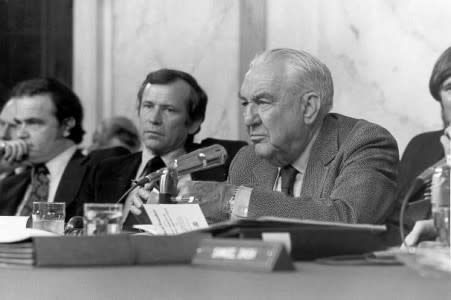10 fascinating facts about Watergate four decades later
On June 17, 1972, police caught five men breaking into the Democratic National Committee headquarters at the Watergate complex in Washington, D.C. So how did a “third-rate burglary” escalate into a near constitutional crisis?
Today marks another important milestone in the Watergate saga: The 42nd anniversary of Richard Nixon’s resignation announcement on national television and radio on August 8, 1974. But the saga took more than two years to unfold.
After that fateful June event, growing press coverage of the developing scandal caught the nation’s attention, as President Nixon’s administration clashed with Congress over the details of an extensive cover-up related to the break-in.
In late July 1974, the Supreme Court ruled unanimously in United States v. Nixon, that the president had to surrender tapes made within the White House to a special prosecutor. On August 9, 1974, President Nixon officially resigned his office, a day after his national speech, rather than face an impending impeachment proceeding in the House.
Nixon’s resignation and Gerald Ford’s ascension to the White House completed a complex constitutional drama that involved all three branches of government, along with key agencies like the CIA, FBI and Justice Department.
Here are a few interesting facts about the Watergate scandal as it developed.
1. A different kind of tape started off the scandals. The burglars used tape to hold open the latches on door locks at the DNC offices. A sharp-eyed security guard, Frank Wills, saw the tape and called the police.
2. Who made the famous “third-rate burglary” comment? That statement was made by press secretary Ron Zeigler at a press conference in Key Biscayne, Florida two days after the break-in. He also warned that “certain elements may try to stretch this beyond what it is.”
3. Bernstein and Woodward did the second story about the Watergate break-in. The first Washington Post story was filed by veteran police reporter Alfred E. Lewis on June 18, 1972. The first Bernstein and Woodward report came on June 19, 1972.
4. Other newspapers played important roles in reporting Watergate. The Post had an undeniable critical role in breaking the scandal, especially with scoops from a source called Deep Throat, but the New York Times, the Los Angeles Times and Newsday had scoops, too.
5. Robert Bork was a figure in the Saturday Night Massacre. The future Supreme Court nominee acted as solicitor general and fired special prosecutor Archibald Cox on October 20, 1973, after Attorney General Elliot L. Richardson quit after refusing to fire Cox, and Richardson’s aide, William Ruckelshaus, was fired for not firing Richardson .
6. Who disclosed the secret taping system? Presidential aide Alexander Butterfield did publicly in the televised Watergate hearings in July 1973, but he privately told investigators the same details a few days prior to the TV appearance. Investigators received a suggestion from the Post about Butterfield in May 1973, after Woodward and Bernstein said they hadn’t checked into Butterfield’s potential role in Watergate.
7. The Supreme Court’s role in ending Watergate. On July 24, 1974, a unanimous Supreme Court ordered Nixon to surrender the White House tapes. The Court rejected Nixon’s claim to an “absolute, unqualified Presidential privilege of immunity from judicial process under all circumstances.”
8. The House’s role in ending Watergate. The House Judiciary committee drew up three impeachment articles on a Saturday night, July 27, 1974, in a process that started in February 1974. Nixon acknowledged in an August 5, 1974 statement about the Smoking Gun tape that he would most likely face a full House impeachment vote and a Senate trial.
9. The Smoking Gun tape as the coup de grace. The release of the Smoking Gun tape, among 64 recordings that Nixon was forced to surrender by the Supreme Court, ended the Watergate drama. The tape showed Nixon ordering a cover-up of the break-in right after it happened in June 1972.
10. The Justice Department pondered a Nixon indictment after his resignation. Justice Department memos show officials struggling with Article I, Section 3, Clause 7 of the Constitution. The clause says that a person removed from office by impeachment and conviction “shall nevertheless be liable to Indictment, Trial, Judgment and Punishment, according to the Law.” But there wasn’t a mention in the Constitution about a President who had resigned from office. Nixon’s pardon a month later ended that debate.
More Constitution Daily Watergate Stories
10 fascinating facts about Watergate four decades later
Watergate’s biggest mysteries remain unsolved
The legacy of Watergate: Five ways life changed after the scandal



